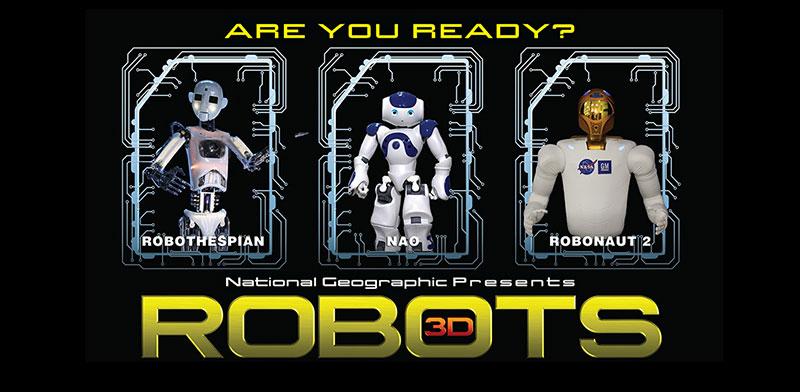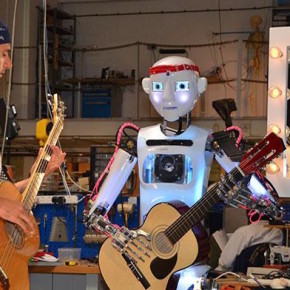
Robohub.org
Nat Geo’s Robots 3D proves that robots don’t need to be sci-fi to be compelling
 Close up, in 3D, what jumps out at you is not just how astonishing today’s humanoid robots are, but also how miraculous the human body they mimic is. National Geographic’s Robots 3D is showing in big screen, IMAX and digital cinemas throughout the world this summer. It presents an authentic and fascinating glimpse into the work of replicating some of our most challenging human characteristics.
Close up, in 3D, what jumps out at you is not just how astonishing today’s humanoid robots are, but also how miraculous the human body they mimic is. National Geographic’s Robots 3D is showing in big screen, IMAX and digital cinemas throughout the world this summer. It presents an authentic and fascinating glimpse into the work of replicating some of our most challenging human characteristics.

Robothespian. Source: National Geographic
Narrator ‘RoboThespian’ (borrowing the voice of Simon Pegg), takes us on a whistle-stop tour of what’s going on in robotics labs around the world, where researchers are putting robots through their paces. We’re party to the successes as well as the failures of a menagerie of humanoids including CHIMP, ATLAS, PR2, Herb the Butler, iCub, and others.
Introducing them one by one, the film highlights how the vast majority of robots featured must focus on achieving just a single, specific task. This is intercut with footage showing just how nimble, adaptable and all-round amazing the human body is, and how robotics struggles to emulate this. Take Herb, for instance; the robot butler’s current level of success in clearing a table is remarkable only for its comedy value. Rollin’ Justin, developed by the Institute of Robotics and Mechatronics in Germany, fares somewhat better with its 90 per cent success rate in catching balls. It’s notable that it has taken Honda more than 15 years of development to get ASIMO, dubbed “the world’s most advanced humanoid robot,” to the stage where it can perform multiple actions such as running, jumping and recognising voices.
Directed by Mike Slee and produced by Jini Dürr (both National Geographic documentary veterans) and enhanced with a dramatic soundtrack, Robots 3D provides a rare glimpse behind the scenes. What comes across with searing honesty is just how hard it is to recreate the most basic human actions such as walking, catching a ball and clearing up after dinner. So, while the movie tells us how we as a society might benefit from robots, we also see them failing the most simple of tasks.

Robonaut. Image: National Geographic
They’re impressive nonetheless and the film brings out some strangely likeable personalities. There were also a few robots I’d not yet encountered, including the highly dexterous Robonaut, used to help astronauts on board the International Space Station. It can handle the same tools as humans and perform tasks such as changing an air filter. And COMAN, a headless wonder with flexible joints that refuses to be knocked down.
We saw Robots 3D at London’s Science Museum, where it’s showing at the IMAX cinema. The kids in our party pronounced it “mind blowing” and “dead interesting” – surely the highest accolades for a movie that is just as much about how far the science of robotics still has to go as its recent progress.
NAO and iCub both scored highly in the cuteness stakes, but it was ASIMO that emerged as the kids’ overall favourite in the show.
The children also declared themselves impressed by HRP-2 (a bipedal bot that can crawl, as well as walk), Rollin’ Justin (of ball-catching fame), and CHIMP (for its ability to scan its local area using laser light and sending out pulses that bounce back). They were intrigued that some of the robots could upload information to the cloud for others to share.
The ATLAS rescue robot, designed by the US Defense Advanced Research Projects Agency (DARPA) for use in emergency situations, is also featured in the movie, as was footage of the DARPA Robotics Challenge (DRC) trials. But, somewhat tellingly, despite DARPA’s efforts to stress their humanitarian applications, the kids wanted to see “a bit more of the military robots.” Perhaps ATLAS needs to take on some of iCub’s cuteness to dispel these kinds of conceptions.
In fact, the kids wanted to see more generally and weren’t satisfied by the 40 odd minute length of the film. They also wanted the robots to do more dancing and climbing.
However, as a vehicle for changing public perception towards robotics, Robots 3D is without doubt a great success. It’s a way for people to learn about humanoid robots from the scientists who make them, rather than from movies like iRobot and Terminator, where they’re portrayed as violent and terrifying.
At Robohub, we’re also proud of our own small contribution to the Robots 3D project, in providing some of the educational material to supplement the documentary.
Robots 3D is a refreshingly realistic take on the current state of humanoid robotics, without minimizing the great strides that have been made to date. But although the movie introduces viewers to some of the most incredible humanoid robots out there today, like any snapshot of a fast developing technology, this portrait won’t be state-of-the-art forever. So go out and see it while it’s fresh!
tags: asimo, ATLAS, c-Arts-Entertainment, cx-Events, iCub, NAO, PR2




